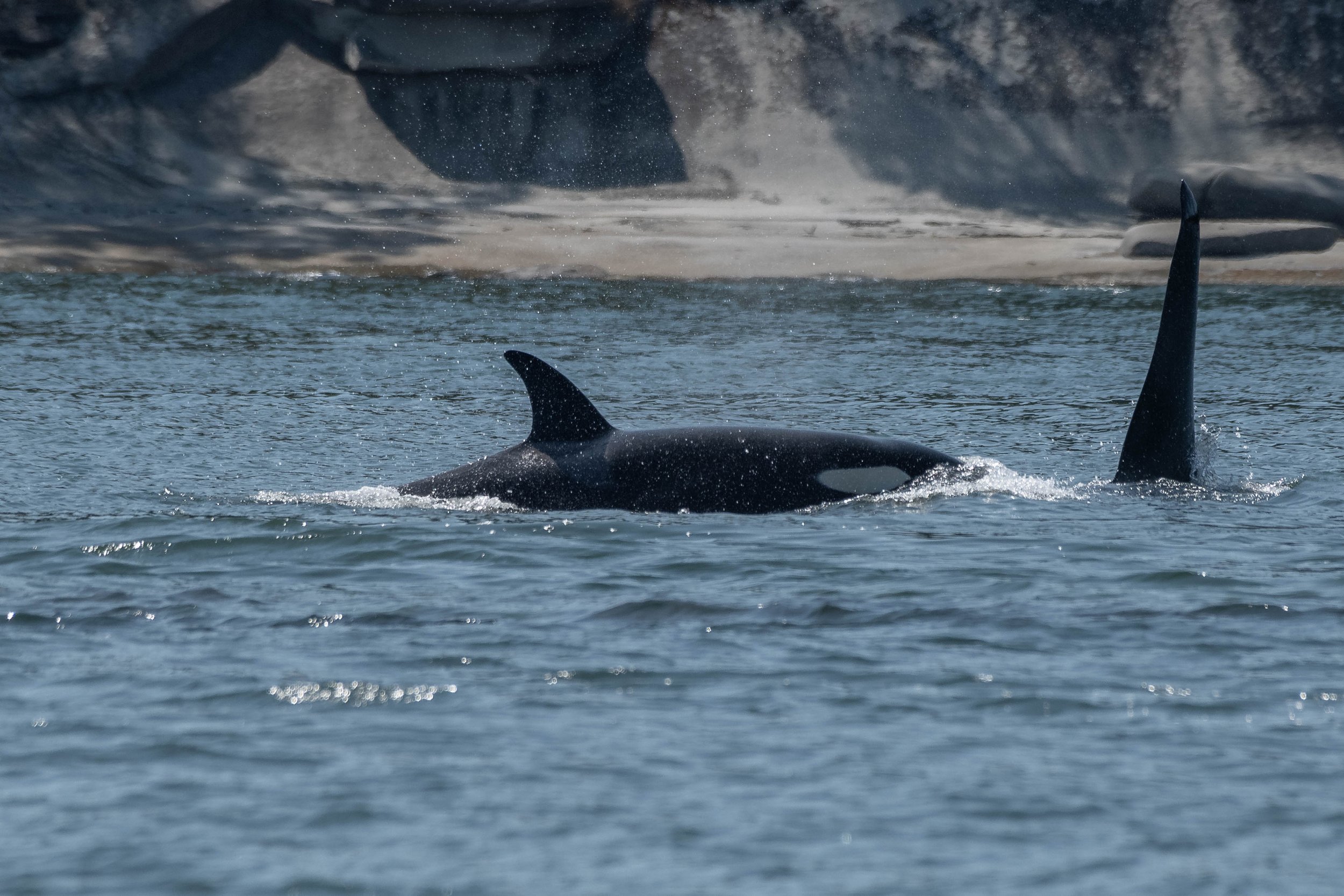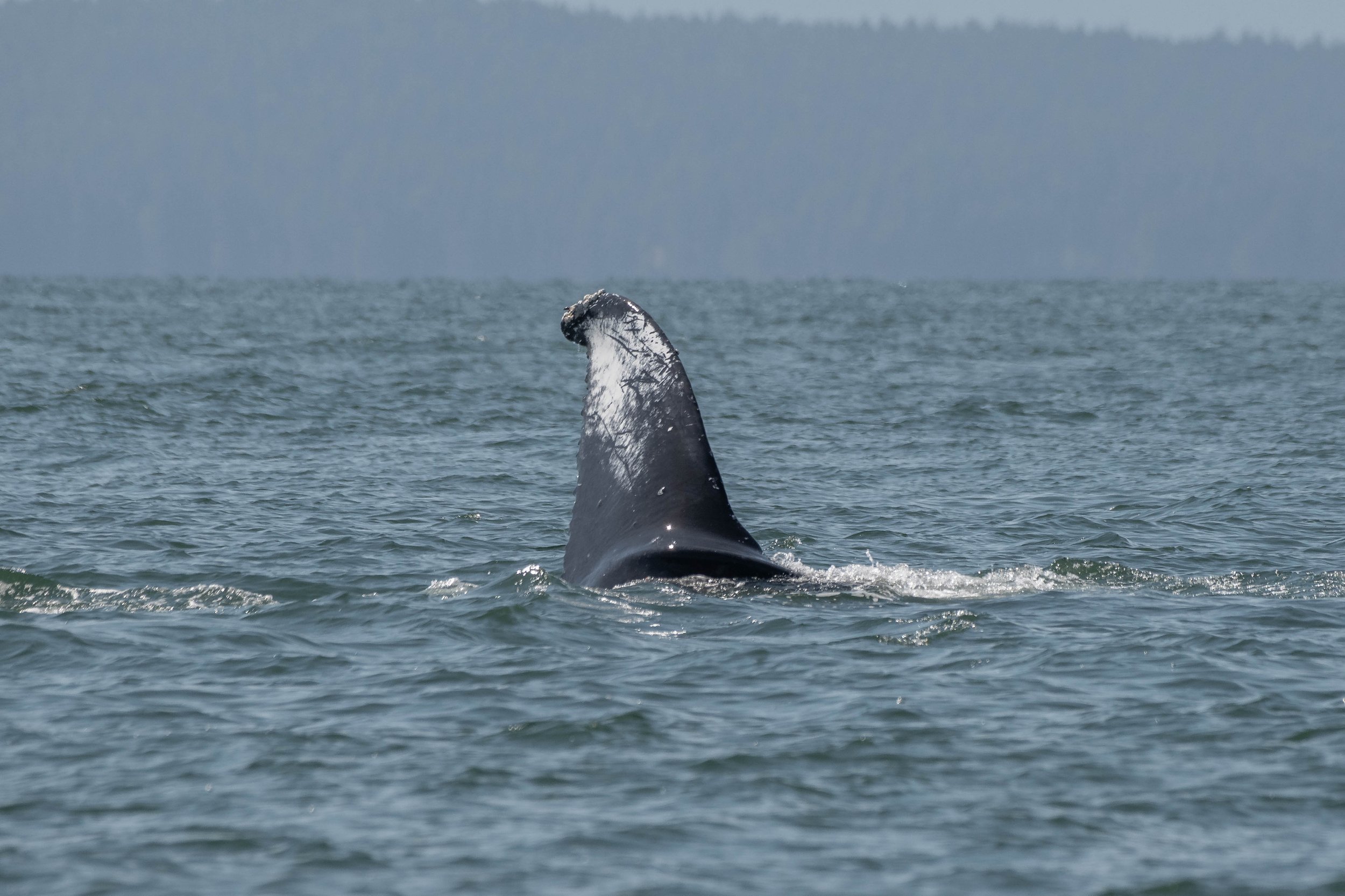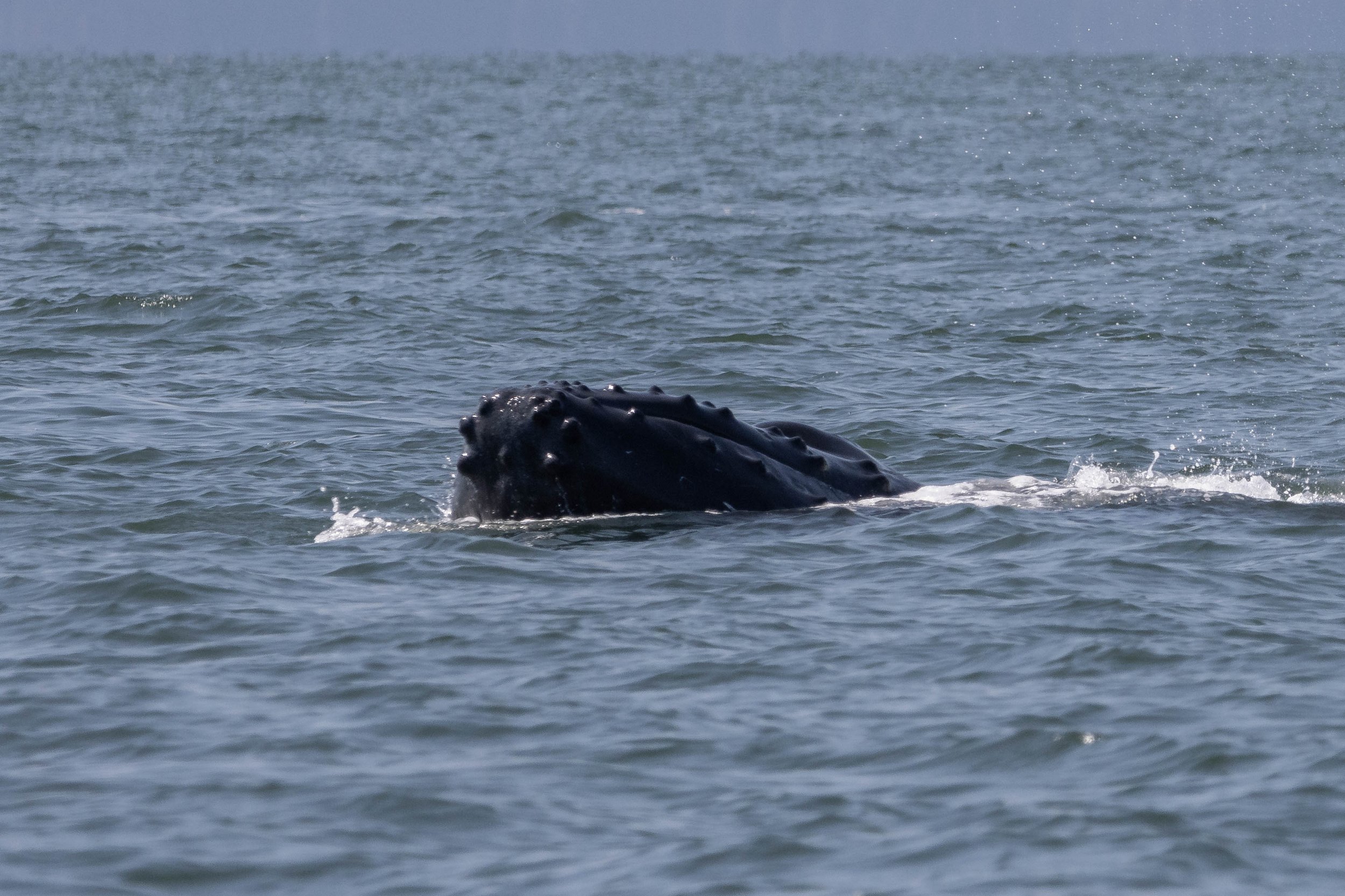August 15, 2024, 10:30 AM - Lunch time for all!
We made our way off the dock on this cloudy morning trying our luck at finding some giants. Our 3 vessels split up to cover as much ground as possible, to hopefully boost our chances. After a little searching, our vessel Keta stumbled on a lone humpback identified as Wisp (BCX1333 calf 2021). This young whale was feeding shockingly close to the shoreline, likely trapping the small schooling fish between the rocks and themselves. Very clever Wisp!
Once their belly was full, this youngster decided to take a little nap. We can tell humpbacks are sleeping because they usually stop fluking, stay just under the surface, and come up for breaths that are much more shallow than their regular ones. Interestingly, whales only rest half their brains at a time, which means Wisp never fully sleeps. While one side of the brain is resting, the other side is awake and aware, allowing them to continue to surface for air, a very important adaptation for these air breathers! After a bit, we left Wisp to their nap, and went in search of more whales!
August is a fantastic month to see humpbacks. In fact, we’ve seen humpbacks on every trip so far this month! British Columbia and Alaska are feeding grounds for humpbacks that breed in Hawaii and Mexico. The colder waters create a nutrient-rich environment that provides an all-you-can-eat buffet for the gentle giants that choose to summer here. This is in stark contrast to the warmer waters of the breeding grounds where the humpbacks have little to no food and are on a 4-6 month fast. Lots of hungry humpbacks make the journey to our little slice of heaven, and because of this Wisp wasn’t the only whale we saw feeding today. Other humpbacks that were filling their bellies were Beak (BCX1606), Crackle (BCY1227), Sage (BCX2073) and Graphite (BCX2077).
It wasn’t just the humpbacks that were hungry today. We were so lucky to get a last-minute report of orcas close to the area we were already in! The 3 vessels went over to the reported area and it didn’t take long to spot Rocky’s massive dorsal fin coming out of the water along with the rest of his fabulous family. Matriarch Tasu has been cruising these waters long enough now that she knows where the best harbour seal haul outs are and this is exactly where Tasu brought her family for some lunch. These expert hunters were able to take down a seal with almost no fanfare whatsoever. A little bit of splashing, a spy hop and it was over. The family shared their meal and moved on to the next spot.
T002C Tasu ♀ (1989)
T002C1 Rocky ♂ (2002)
T002C3 Lucy ♀ (2011)
T002C5 (2020)
There’s often a comparison between orcas and wolves with orcas being called “the wolves of the sea”. This tends to lead to confusion around how family structures work with the orca with a lot of people assuming that the male is “the alpha” or that the largest male and female are a mated pair. This isn’t the case with Orca pods. Males do not help raise their own calves, nor do they lead the group. In fact, males typically stay with mom their entire lives and because orcas live in a matriarchal society, Mom is the boss! So when seeing this family of 4, Tasu is the leader of the family and the other 3 (including massive male Rocky) are subordinate to her. Lucy who is Tasu’s eldest daughter will eventually leave and start her own family once she has calves of her own. Sadly for us, we had to leave this wonderful family and head back to the dock as the tour came to a close.
If you would like to see pictures of the whales we saw today or the other fantastic wildlife we encountered, you can check out the photos below! All photos were taken by onboard Marine Naturalists Aly Kohlman, Lucy Willis, and Hayleigh Hilbert.
Rocky with his younger siblings. Photo by Aly Kohlman
Rocky's dorsal fin is likely around 6 feet tall! Photo by Aly Kohlman
Tasu checking out the fast food menu. Photo by Aly Kohlman
T002C5 following big brother Rocky while they hunt. Photo by Aly Kohlman
Tasu and Lucy surfacing together. Photo by Aly Kohlman
Lucy spy hopping in front of mom Tasu. Photo by Aly Kohlman
T002C5 participating in a hunt with family. Photo by Lucy Willis
Tasu swimming past some harbour seals. Photo by Lucy Willis
Rocky coming up for a breath. Photo by Hayleigh Hilbert
A beautiful spy hop. Photo by Hayleigh Hilbert
Crackle showing off the ventral side of their fluke. Photo by Aly Kohlman
Wisp about to go for a dive. Photo by Hayleigh Hilbert.
Sage and Crackle surfacing together. Photo by Aly Kohlman
Pectoral fins can be 1/3rd the length of a humpback's body. Photo by Aly Kohlman
Did you know we can identify individual humpbacks using the ventral side of the flukes? This is Wisp. Photo by Hayleigh Hilbert
Beak showing us the ventral side of his beautiful flukes. Photo by Hayleigh Hilbert
Some fun in the sun! Photo by Hayleigh Hilbert
Did you know the bumps on a humpback's mouth are called tubercles? Photo by Lucy Willis
Wisp feeding close to shore. Photo by Lucy Willis
A harbour seal pup next to mom. Photo by Aly Kohlman
Steller sea lions fighting for the best spot. Photo by Aly Kohlman
A Steller sea lion enjoying some sunshine. Photo by Hayleigh Hilbert
A young male Steller sea lion. He may be bigger than the others but he still has a lot of growing to do. Photo by Aly Kohlman
A flock of birds gliding over the water. Photo by Aly Kohlman
The coast guard hover craft making it's way across the sea. Photo by Hayleigh Hilbert

























